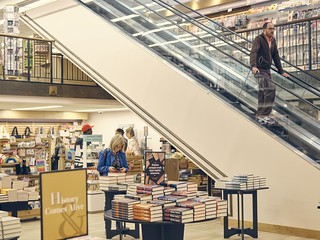
PREV ARTICLE
NEXT ARTICLE
FULL ISSUE
PREV FULL ISSUE
THE BARNES & NOBLE BOOKSTORE REVAMPFor bibliophiles, a Wall Street Journal article looks at the recent turnaround at Barnes & Noble. -Editor
That shop in one of the world's greatest book markets has been a battleground since the day it opened three decades ago. It might be the most iconic of the chain's 596 locations: It's the store that helped inspire the mega-store run by Tom Hanks's character in the classic romantic comedy It also has been the site of a grand experiment for much of the past year. The chain invested millions of dollars to rebuild this Barnes & Noble into a model for its other stores to emulate as the company transforms into a bookseller for the modern age. As a privately held company, Barnes & Noble doesn't report financial results, but it's clear that it's no longer near death. While the number of locations has decreased 5% since the acquisition, the chain is now expanding and plans to open 45 stores this year, including some that closed and reopened with smaller footprints, like one on the Upper East Side that opened this month to a line around the block. It's also giving facelifts to existing shops across the country. But not every store needs a complete makeover to feel refreshed. I recently popped into a Barnes & Noble off the interstate in Pueblo, Colo., where even subtle tweaks made for a delightful browsing experience. Barnes & Noble used scale and uniformity to its benefit in the 1990s and 2000s, but those advantages have since become liabilities. Bookstores don't have to be the same from one to another. They shouldn't be, either. The best managers know the books they sell and the customers who buy them—and what works on the Upper West Side might not work in West Des Moines. The major renovation was necessary because the mission of bookstores has changed since this one opened in 1993. Back then, someone who wanted a specific book would visit their favorite brick-and-mortar store. Now anyone in need of that book probably visits Amazon. This profound shift in consumer behavior prompted Barnes & Noble to reconsider the very purpose of a Barnes & Noble. A physical bookstore competing against a $1.4 trillion online everything store must give people the stuff they know they want and the stuff they didn't know they wanted.
There's not always a right answer. But there are wrong answers. It baffles Daunt that 20% of the chain's locations sort history books alphabetically by author. I wholeheartedly agree with the emphasis on browsing. That's the delight of visiting libraries and bookstores (both new and used). If you already know exactly what book you want, just order it online. To find the books you never heard of but didn't know you wanted, browsing in a store is ideal, and discovering a new title is a treat. -Editor
To read the complete article (subscription required), see:
Wayne Homren, Editor The Numismatic Bibliomania Society is a non-profit organization promoting numismatic literature. See our web site at coinbooks.org. To submit items for publication in The E-Sylum, write to the Editor at this address: whomren@gmail.com To subscribe go to: https://my.binhost.com/lists/listinfo/esylum All Rights Reserved. NBS Home Page Contact the NBS webmaster 
|
